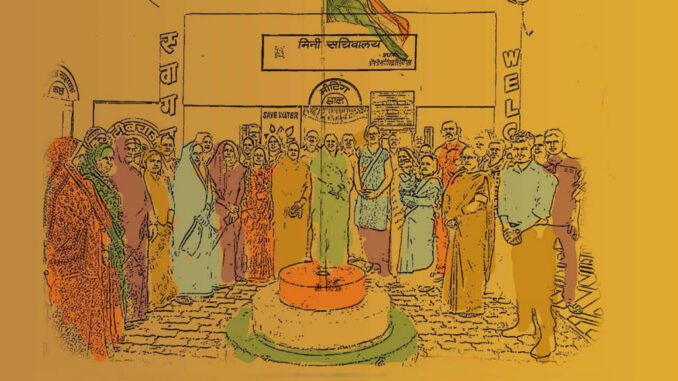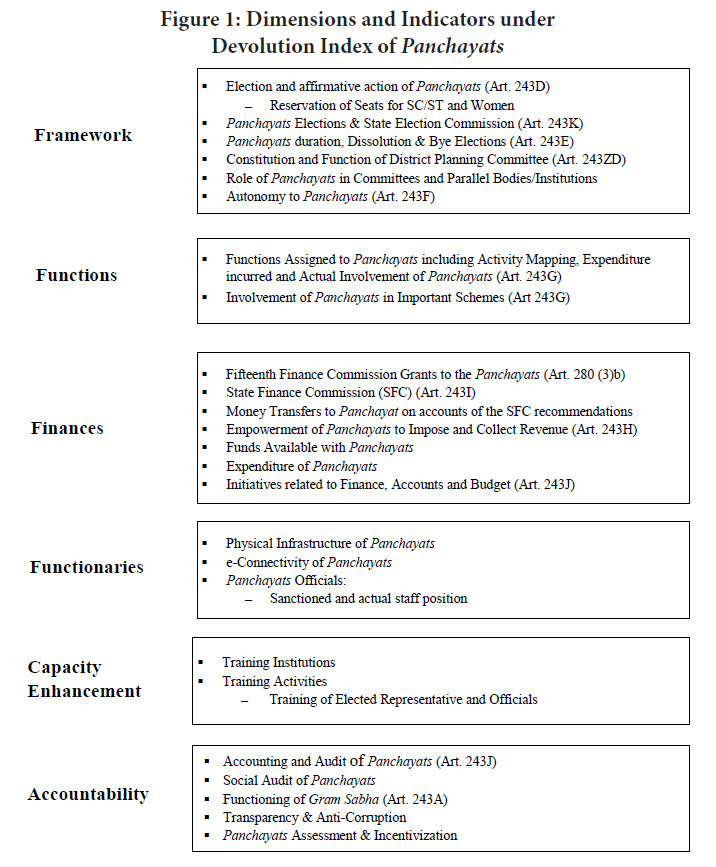
Panchayats, as rural local self-government institutions are called in India, constitute a fundamental component of India’s multi-order federal system. Their authority is derived from the State, the sub-national entity responsible for nurturing and developing them. In this attempt, the Union Government provides necessary assistance to the States to ensure compliance with the legal provisions of the Constitution outlined in Part IX, as evidenced by the 73rd Constitutional Amendment Act of 1993.
Ten years after the constitutional changes, in 2004, it was agreed to have annual reports on the state of the Panchayats, including the preparation of a Devolution Index in the format indicated by Alok and Bhandari (2004). From 2006/07 through 2008/09, the National Council of Applied Economic Research (NCAER) developed the Devolution Index based on the work of Alok and Bhandari (2004). During the following four years, the Indian Institute of Public Administration was entrusted to carry out the assessments.
In 2012, the study went beyond the dimension of “4Fs” (Framework, Functions, Finances and Functionaries) and two new dimensions were added, notably, ‘Capacity Building’ and ‘Accountability’. The subsequent studies conducted by IIPA improved upon various aspects of previous studies such as number of indicators. For the years 2014/15 and 2015/16, a devolution report was prepared by TISS using many indicators, not all, of the previous studies.
Objective of the assessment
After a gap of seven years, the Indian Ministry of Panchayati Raj, entrusted an updated study on the Status of Devolution of Powers and Resources to the PRIs across the States and Union Territories to the Indian Institute of Public Administration. The report, which was authored by VN Alok, had the following primary objectives:
- To assess the actual progress in implementing the operative core of decentralization covering the transfer of functions, institutions, functionaries, and finances to Panchayati Raj Institutions in the subjects listed in the 11th schedule of the constitution of India.
- To examine the role of the Panchayats as institutions of local self-government with various committees at the local level and the role of the Panchayat in managing institutions at the local level.
- To arrive at an indicative ranking on the status of devolution based on the above parameters through field studies and through appraisal of state level data sets.
- To assess the role of Panchayats vis-à-vis Centrally Sponsored Schemes (i.e., federal grant programs).
The Devolution Index
The Devolution Index presents the overall scores and ranks for States/UTs on the six identified dimensions: (1) Framework, (2) Functions, (3) Finances and (4) Functionaries, (5) Capacity Building and (6) Accountability. Table 1 categorizes the States according to the score received of dimensions as well as the overall Devolution Index (DI), which forms the basis to present the ranks of States/UTs.

Based on the weighted aggregation of six dimensional sub-indices, the composite DI is computed for the States/UTs. Table 1 and Figure 2 depict that State of Karnataka ranks first in the present ranking with an index score of 72.23, followed by Kerala (70.59), Tamil Nadu (68.38), Maharashtra (61.44) and fifth, the State of Uttar Pradesh (60.07). Further, Gujarat is ranked sixth with a score above 58.26. The scores highlight a significant gap between the top three States and the rest.
Discussion of Top-Ranking States
Karnataka tops the chart in the Devolution Index, as well as in the key sub-indices of ‘Finances’ and ‘Accountability’ as clear from the table and graph. Overall analysis of indicators demonstrates the State’s commendable performance across nearly all identified metrics. Karnataka delegates a significant number of functions to Panchayats while assigning them substantial roles in vertical schemes designed by the Union government.
The State is among the front runners in releasing and utilizing the grants-in-aid of the 15th Finance Commission in time. On account of the State Finance Commission recommendations, the money is released to Panchayats in a timely manner. Panchayats in the State enjoy maximum power to levy taxes and non-taxes. The State has topped in the ‘Accountability’ dimension as well with the highest score in the indicator of ‘Social Audit’ and ‘Gram Sabha’. Under the ‘Functionaries’ dimension, the State has one of the maximum number of Panchayat officials working as per the sanctioned positions prescribed by the State. In the ‘Capacity Building’ dimension, the State comes in top ten States having training institutions both at State and Panchayat levels. It may also be recollected that the State had received awards in the past under devolution index, for creating the environment for the Panchayats to function as institutions of self-government. Overall, the gram Panchayat system in Karnataka serves as a vital institution for promoting local self-governance, participatory democracy, and sustainable development in rural areas.
Kerala follows Karnataka in the Devolution Index. Kerala occupies first place in ‘Framework’, second position in ‘Accountability’ and ‘Finances’ and ranked third in the dimension of ‘Functionaries’. Functioning of Panchayats in the State is considered highly transparent. The State has tried to devolve most of its functions to Panchayats and at the same time has maintained a transparent system of transferring money under the Panchayat’s window. The institution of state finance commission in Kerala has emerged to be the most effective in the recent past. Panchayats in Kerala utilize funds adequately and share the top slot as far as the indicator related to ‘fund utilization’ is concerned. Under the dimension of ‘Accountability’, the State has one of the best ‘Transparency and Anti-Corruption’ and ‘Panchayat Assessment and Incentives’ mechanisms. The state has adequate actual staff for the effective functioning of Panchayats as found from the study. The state is good in training Panchayat officials due to adequacy in training institutions for capacity building of the resources.
Tamil Nadu is ranked third in the overall index. According to the study, the State has the highest score in the ‘Functions’ dimension, second in ‘Capacity Building’ and ‘Functionaries’ and third in ‘Finances’. In the State, the involvement of Panchayats in the schemes has the highest level of engagement by Panchayats in comparison to its counterparts. Panchayat officials at local level are accountable to Panchayats. In the dimension of ‘Capacity Building’, the State is good in assessing the need and conducting training for Panchayats’ representatives and officials. The state of Tamil Nadu seems to perform well in the indicator of ‘training institutions’
Maharashtra stands at fourth position in the Devolution Index, second in the key dimension of ‘framework’ and at the third in Accountability. Overall indicator analysis shows that the State has performed decently in almost all indicators identified in the study. The State is among the front runners in releasing the 15th Finance Commission grant in time. Panchayats in the State enjoy maximum power to levy taxes and non-taxes. Panchayats in Maharashtra utilise funds adequately and share the top slot with their counterparts as far as the indicator related to expenditure is concerned. The State ranked at third position in the ‘Accountability’ dimension with a good score in the indicator of ‘transparency and anti-corruption’. Under the ‘Functionaries’ dimension, the State keeps the maximum number of actual staff in comparison to the sanctioned staff. It may be recollected that Maharashtra has a historical background of strong legal and policy framework. It may be noted that a comprehensive Act for Zilla (district) Parishad and Panchayat Samiti was enacted way back in 1966. A separate Act is in place for Gram Panchayats. Time to time amendment has been made. Development cadre at zilla parishad level executes these elaborated legal provisions.
The performance of Uttar Pradesh has been remarkable in the overall index and is ranked fifth and scored well in the dimension of ‘Accountability’. Panchayats in the State have released and have even spent the released grant by the 15th Finance Commission in time. The State has also introduced ‘Initiatives related to Finance, Accounts and Budget’. The State of Uttar Pradesh is making efforts towards accountability mechanism and ranks fourth position in this dimension and has the highest score in the indicator of ‘Accounting and Audit’. Under the ‘Functionaries’ dimension, the State has tried to fill the posts of Panchayat secretary by recruiting the resources through exams in the recent past. The State has adequate staff for the functioning of Panchayats.
Devolution performance for PRIs varies greatly among Indian States
Karnataka, Kerala, Maharashtra, Tamil Nadu, and Uttar Pradesh, with scores above 60, are categorized as ‘very high’ in the overall Devolution Index. This is followed by Chhattisgarh, Gujarat, Rajasthan, Telangana, Tripura, and West Bengal, which are rated as high performing States.
With the score in between 50 and 55, Andhra Pradesh, Himachal Pradesh, Madhya Pradesh, and Odisha, fall under the category of ‘medium scoring’ States, showcasing commendable performance across all sub-indicators. Similarly, four other States are classified as ‘low performers’ in devolving power to Panchayats. These States, namely, Assam, Bihar, Sikkim, and Uttarakhand, surpass the national average, i.e., 43.89.
However, twelve other states, which include Goa, Haryana, Jharkhand, Punjab and two northeastern States of Arunachal Pradesh, and Manipur, along with six union territories of Andaman & Nicobar Islands, Dadra & Nagar Haveli and Daman & Diu, Jammu and Kashmir, Ladakh, Lakshadweep, Puducherry, still lag below the national average of 43.89 and are regarded as aspirational.
Read the full report (available on the website of the Ministry of Panchayati Raj):
VN Alok. 2024. The Status of Devolution to Panchayats in India, 2024: An Indicative Evidence Based Ranking. Indian Institute of Public Administration.



